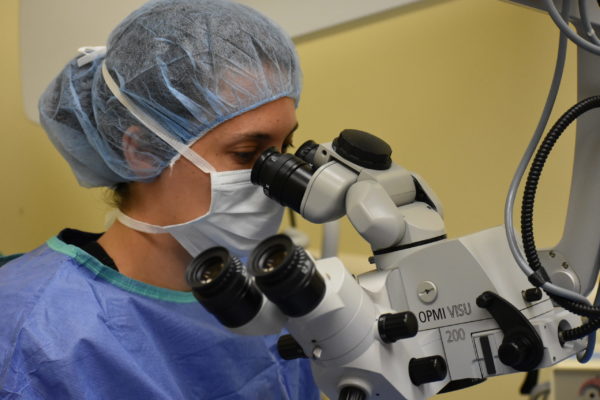
Your pet’s eyes are one of their most important organs, and preserving their sight is one of our ophthalmology department’s top priorities. You may not realize that pets can develop many of the same eye problems as people but, thankfully, advances in veterinary medicine mean we can provide the same cutting-edge technology.
A cataract is an opacity that develops in your pet’s lens, a structure in the center of the eye that helps focus images. An opacity on the normally translucent lens interferes with vision, and advanced cataracts can cause complete blindness and inflammation inside the eye. Cataracts are one of the most common ophthalmologic problems that can interfere with your pet’s vision.
Cataracts can develop slowly over many years, or quickly in a few days, depending on the inciting cause. Some cataracts affect only a portion of the lens and minimally affect vision, whereas others affect the entire lens and cause blindness.
Cataracts can develop in older pets as a result of aging, but they are also related to a number of medical conditions, including diabetes. Some breeds have a genetic predisposition to cataract formation, including:
The most common cataract sign is a cloudy or bluish-grey appearance to one or both eyes. Another medical condition, nuclear sclerosis, can also cause a cloudy appearance to your pet’s eyes, but it is a normal age-related change that does not interfere with vision. Therefore, your family veterinarian should always examine your pet immediately if you notice any cloudiness in the eyes.
Your veterinarian will perform a thorough ocular exam to differentiate cataracts from normal aging changes and other eye conditions, and may refer your pet to our ophthalmology department for further evaluation if they believe cataracts are present.
After an initial consultation to confirm your pet has cataracts, we will perform an electroretinogram (ERG) to ensure your pet’s retina is functioning normally, as well as an ocular ultrasound to screen for abnormalities in the back of the eye. We will also perform several tests, including blood work and urine testing, to evaluate your pet’s overall health and check for diseases that may be contributing to cataract formation.

The only effective cataract treatment is surgery, which can be performed at our Greeneville and Asheville locations. Unless cataracts are causing your pet discomfort, surgery is an elective procedure, and we will help you determine your pet’s best option. During cataract surgery, an incision is made through the lens capsule, the damaged lens is broken up using a phacoemulsification unit, and the lens is removed and replaced by a prosthetic lens that is implanted in the capsule. Surgery is typically successful, but complications occur in 10% to 15% of cases.
Blind pets often live happy, functional lives, so if cataract surgery is not the best option for your pet, she can still have a good quality of life. However, chronic cataracts can cause inflammation inside the eye, so if your pet cannot have surgery, daily, life-long anti-inflammatory eye drops may be prescribed.
Cataract surgery is typically an outpatient procedure, although your pet may require observation overnight. We will send your pet home with eye drops you will need to administer several times a day for at least one month, and we may prescribe additional medications to be administered indefinitely to minimize long-term scarring and inflammation. Also, your pet will need to wear an e-collar for two to three weeks to prevent them from traumatizing or scratching the eye, and bathing and activity will be restricted for the first month. Your pet will require frequent progress checks to ensure the eye is healing normally.
If you think your pet may have cataracts or other eye problems, immediately contact your family veterinarian, who may refer you to our veterinary ophthalmologists for specialty care, and you then should contact us to schedule a consultation.